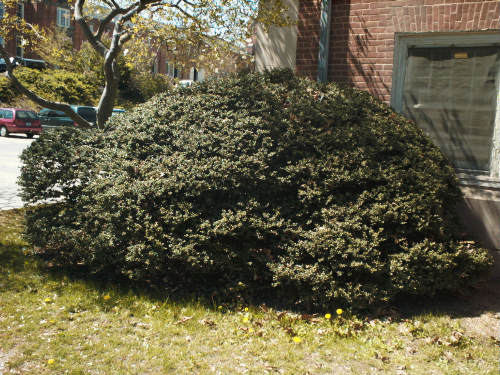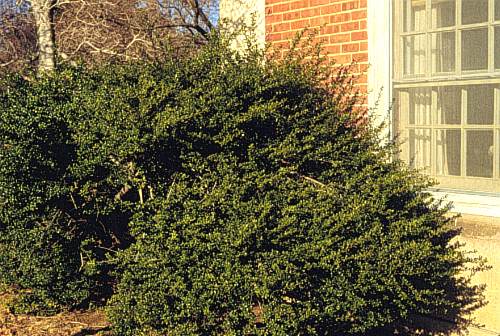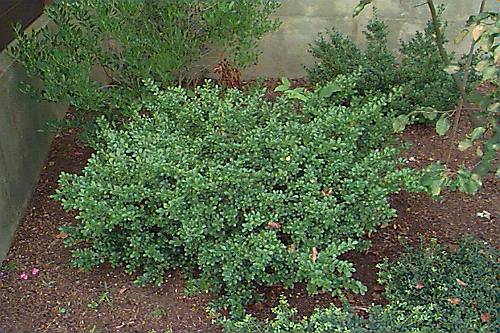Ilex crenata
Japanese Holly, Box-leaved Holly
Aquifoliaceae
ExpandHabitat
- native to Japan
- zone 5 (warmer sections)
Habit and Form
- evergreen shrub with compact, upright, spreading habit
- dense with lots of rigid branches
- medium to fine texture
- 6' to 10' tall and at least as wide
- size is variable and dependent on cultivar
- nearly all plants used in landscaping are selections and the species is very rarely seen
- slow growing
Summer Foliage
- dark green, lustrous leaves
- evergreen, usually broadest in the middle
- alternate leaf arrangement
- leaf margin serrate from base to tip
- leaves mostly 1" to 2" long
Autumn Foliage
- evergreen, so no fall color
- leaves also shiny in winter season
Flowers
- dioecious, with male and female plants
- blooms in May into June; not showy
- small, dull white flowers in clusters of 3 to 5 (male)
Fruit
- female plants may produce 0.25" diameter black fruit
- male plants bear no fruit, but are needed as pollinators
- fruit in September - October; often persist until spring
- fruits borne below the foliage and hidden
- fruit is not ornamentally significant
Bark
- smooth
- gray-brown or slightly greenish
- generally hidden by density of the canopy
Culture
- needs protection from drying winter winds
- full sun to partial shade
- easily transplanted from container or B&B
- withstand significant pruning or shearing
- moist, slightly acid soils, well-drained soils are ideal
- tolerant of conditions in urban gardens
- plant 6 feet apart in mass plantings
- plant 3 feet apart in hedges
Landscape Use
- as a foundation plant
- hedges
- borders
- in mass planting
- useful for high quality evergreen foliage
- for formal gardens with sheared plantings
Liabilities
- lack of all around cold hardiness in any location in zone 5
- foliar burn, twig kill in severe winters
- spider mite can be problematic in planting incorrectly sited in hot, dry locations
- Thielaviopsis blight can cause twig death on stressed plants
- somewhat overused in some neighborhoods or regions
- iron chlorosis on high pH soils
ID Features
- alternate leaf arrangement and small marginal serrations separate it from Buxus sp. which has opposite leaves and no serrations
- dense, rigid, multibranched habit
- lustrous evergreen leaves
- black fruit
Propagation
- by semi-hardwood or winter cuttings for cultivars
- seed exhibit a dormancy an can be slow to germinate
Cultivars/Varieties
Many cultivars are known, but few are generally available. Below is a representative listing.
'Beehive' - This is a dense, compact form hybridized at Rutgers University. The plant grows to 4' tall and wider, with glossy deep green foliage.
'Convexa' - Named after its leaves -- which are convex when viewed from above -- this is a common, popular cultivar which may be sheared as a hedge. It may grow to 10' tall and twice as wide, with heavy crops of black fruit.
'Golden Helleri' (also listed as 'Helleri Dwarf Golden' and 'Golden Heller') - This is essentially a yellow-leaved 'Helleri'. It holds its color but needs some protection from winter winds. Other gold-foliaged forms are gradually entering the market.
'Helleri' - A very popular dwarf form, this plant forms a low flat mound of layered branches. It reaches 4' tall and usually does not flower or fruit.
'Hetzii' - This is essentially a larger form of 'Convexa', growing to 10' tall with larger leaves. It may be less cold hardy than other types.
'Sky Pencil' (listed as Sky Sentry™ in Canada) - This is a strictly upright, fastigiate form that is becoming more common at nurseries. It grows to 8' tall, but less than 12" wide. It may be used as a formal accent or container specimen.
'Variegata' - This is a catch-all name for many separate clones with different degrees of foliar variegation. Some bear yellow markings, whereas others have leaves almost completely white. These plants are commonly available from specialist nurseries.


















